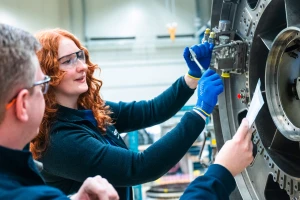innovation
How to plan engine MRO at minimum cost
LATAM uses MTU’s intelligent engine maintenance costing and planning tool for fast, flexible and extremely cost-effective maintenance strategies for its fleets.
author: Victoria Nicholls | 3 mins reading time published on: 01.12.2021
author:
Victoria Nicholls
is an international communications expert. At MTU, she specializes in engine programs and market trends.

The LATAM V2500 engine fleet is big. At over 200 engines, very big, in fact. And it is complex. LATAM’s aircraft are based across multiple countries with different regulations and jurisdictions. Not to mention that the fleet also operates in a whole range of climates.
These factors create a myriad of very individual engine maintenance requirements and complicated planning needs for South America’s largest airline. These range from different maintenance workscopes for leased compared to owned engines, different usage patterns and in turn scrap rates for parts, as well as considerations such as the remaining number of flight cycles available on life-limited parts (LLPs), which need to be exchanged once limits are reached according to aviation authority and safety regulations.
“It is hard to come up with an optimized plan using simple tools,” states Paulo Rimbano, Director of Engineering at LATAM. Hardly surprising, when one considers that each engine has five modules and up to 30,000 parts. “In fact, there’s no way to achieve the optimum long-term planning strategy and, in turn, large cost savings without a complex and highly flexible instrument like CORTEX. It creates a highly detailed and visualized plan for us to work with.”
How it works:

- Data from an airline fleet including operational parameters and cost structures is fed into the system—these can be updated continuously
- This is combined with MTU’s shop visit experience and existing data pool
- Variables such as downtime, usage, contract length and engine ownership can be selected and personalized
- Optimization parameters such as LLPs and use of serviceable material or green-time engines can also be adapted
- Once settings have been chosen, the numbers are then crunched by our artificial-intelligence-assisted algorithms to play out the billions of options for engines
- Over 40 different engine configurations are taken into account per engine type
- CORTEX produces improved, relevant results right down to the parts level in a matter of seconds. This also includes estimated cost per flight hour, number of shop visits over contract period, analysis according to selected KPIs and expected spare engine needs
- MTU experts review the MRO scenarios and validate them
- These scenarios are discussed with the airline to help them make the best decision for their fleet
More than just software
CORTEX is MTU Maintenance’s intelligent maintenance costing and planning tool. A combination of technical data, algorithms and artificial intelligence, it reduces cost per available seat mile and increases engine dispatch reliability for airlines. LATAM has been a beta tester since August 2020, working closely with MTU’s engine experts to generate planning scenarios and assess the resulting MRO strategies with MTU to reduce overall MRO cost across the lifetime of its fleet.
LATAM has been providing real-time data from its operations and feeding it into the MTU system, where it is combined with MTU’s extensive shop experience. “Right now, we’re obviously very focused on short-term planning,” says Leandro Abreu Pezzo, Maintenance Center Manager, LATAM.
MTU’s tool is easily adjustable and allows customers to play around with utilization scenarios – which is particularly useful to airlines in the highly dynamic market that has resulted from the pandemic and in the subsequent recovery of air travel. It also takes into consideration airworthiness directives (ADs) and service bulletins (SBs), which are technical improvements necessitated by the aviation authorities, like for instance the hub AD currently necessary for V2500 engines and flight safety.
“Planning and staggering engine removals for maintenance is challenging. If you are too conservative, it will cost too much, because you’re not using all the life you have in the engine,” Pezzo adds. “But if you are too reactive, it will cost you even more, because you waited for problems to occur. It’s a thin balance between the two.” Pezzo also points out that this might be manageable on a smaller fleet, but for LATAM’s over 200 engines, it is extremely complicated. “That is the reason why MTU’s software CORTEX has proven to be an amazing tool that allows us to reach the optimum state.”
But the tool goes much further than immediate plans and mere removal staggering and redelivery plans. It can plan workscopes down to a modular level, something not currently available on the market today. Additionally, it takes into account multiple variables such as LLP pricing, scrap rate predictions, used serviceable material availability, green-time engines and lease return requirements.
“It’s fascinating to see how a small tweak now, for instance in how we use our available green-time in the fleet or taking a lease engine instead of carrying out a maintenance event, and the cost benefits that has long-term.” MTU’s tool and subsequent analysis from its engine experts can also tailor optimal engine retirement scenarios.
“If you don’t have the real-life technical expertise, MTU’s software solution can be extremely helpful,” Rimbano adds. “CORTEX is a proprietary tool. And MTU has the engine knowledge and experience to manage the resulting maintenance and shop visits. They can execute the plan and we trust them to do so.”






